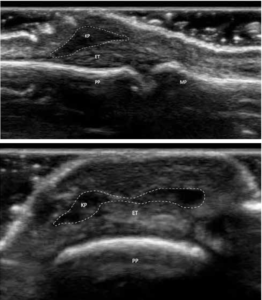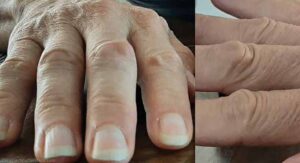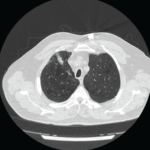The Case
A 56-year-old white woman was evaluated for a one-year history of painless bumps on the dorsal aspect of the proximal interphalangeal (PIP) joints of both hands and suspected flexor tenosynovitis in her palms. On examination, small cystic nodules without erythema or tenderness were present on the dorsal aspect of several PIP joints (see Figure 1). The PIP joints had normal range of motion and no swelling or tenderness. She had induration along the course of the third flexor tendon without frank triggering or contractures. Hand radiographs were normal.
A musculoskeletal ultrasound examination was performed to assess for synovitis and tenosynovitis and to evaluate the nodules on the PIP joints and the palms. The ultrasound demonstrated the underlying third PIP joint and extensor tendon were normal, but it revealed a cystic, semi-lobulated lesion with hypoechoic and isoechoic features, which was partially compressible (see Figures 2 and 3) and exhibited a mild (grade 1) Doppler signal.
An evaluation of the palmar aspect of the right hand revealed an ill-defined hypoechoic lesion superficial to the flexor tendon proximal to the third metacarpophalangeal (MCP) joint (see Figures 4 and 5). It did not move with the underlying tendon, and the lesion had no Doppler signal. The underlying flexor tendon, the MCP joint and the A-1 pulley were normal. Diagnosis of PIP joint knuckle pads, in association with Dupuytren’s contracture, was made. No further intervention was recommended.
Discussion
Knuckle pads are benign subcutaneous nodules on the dorsal aspect of the PIP joints. Rarely, they are seen on the dorsal aspect of the MCP joints.1 These fibro-fatty nodules can be bilateral and are painless. Knuckle pads are usually idiopathic, although rare associations have been reported with repeated trauma and Dupuytren’s contractures.2-4 They are not associated with underlying joint or tendon abnormalities.

FIGURES 2 & 3: Dorsal longitudinal and transverse B-mode ultrasound views of the knuckle pads. Subcutaneous hypoechoic mass can be seen (enclosed in dotted lines). Key: MC: metacarpal; PP: proximal phalanx; ET: extensor tendon; KP: knuckle pad. (Click to enlarge).
No intervention is needed for these benign nodules. They usually come to the physician’s attention for cosmetic reasons or due to concerns of arthritis. An accurate diagnosis should be made after excluding other causes, such as gouty tophi, rheumatoid nodules, ganglion cysts, Bouchard nodes, synovitis and other rarer causes of nodules, such as multicentric reticulohistiocytosis.




